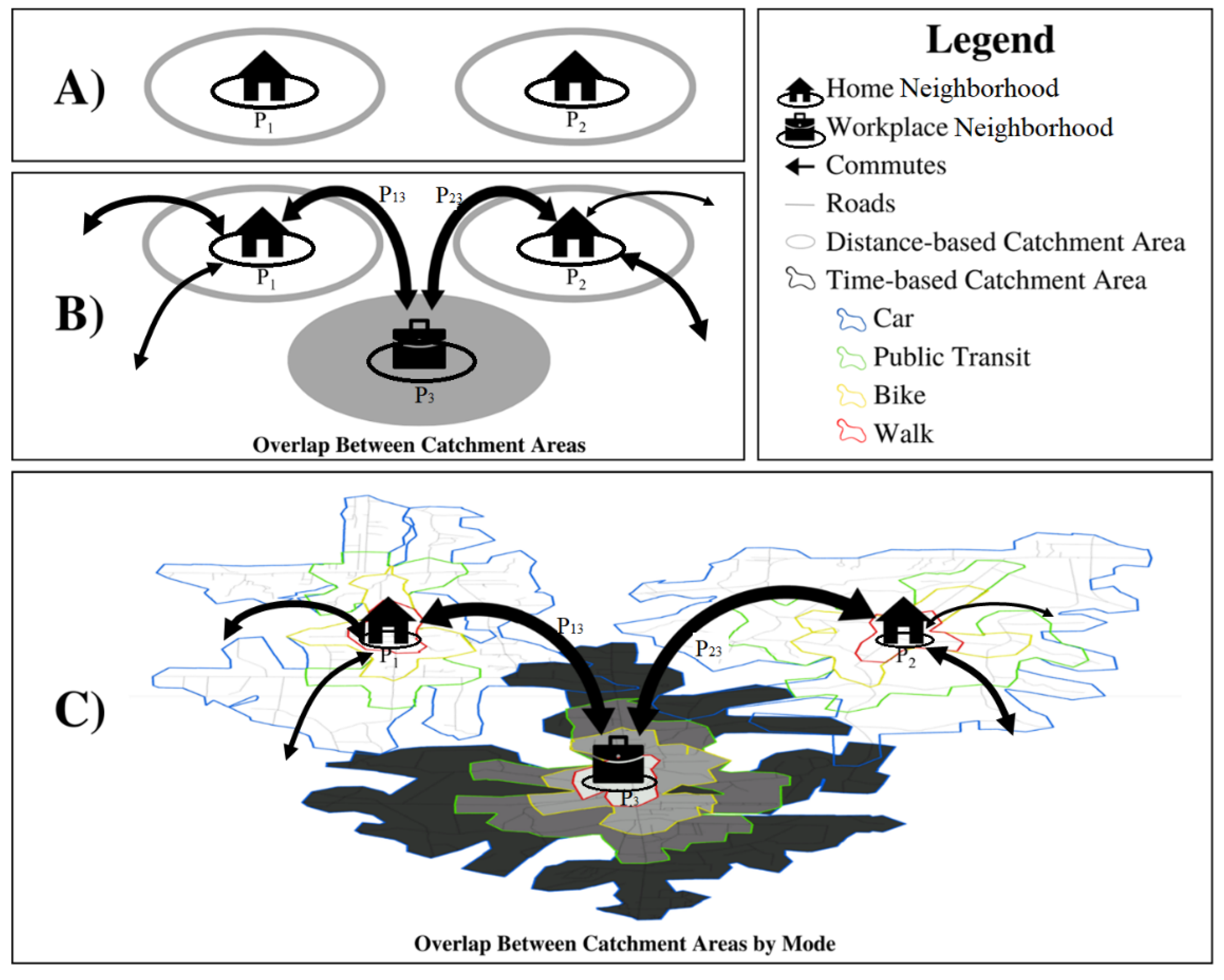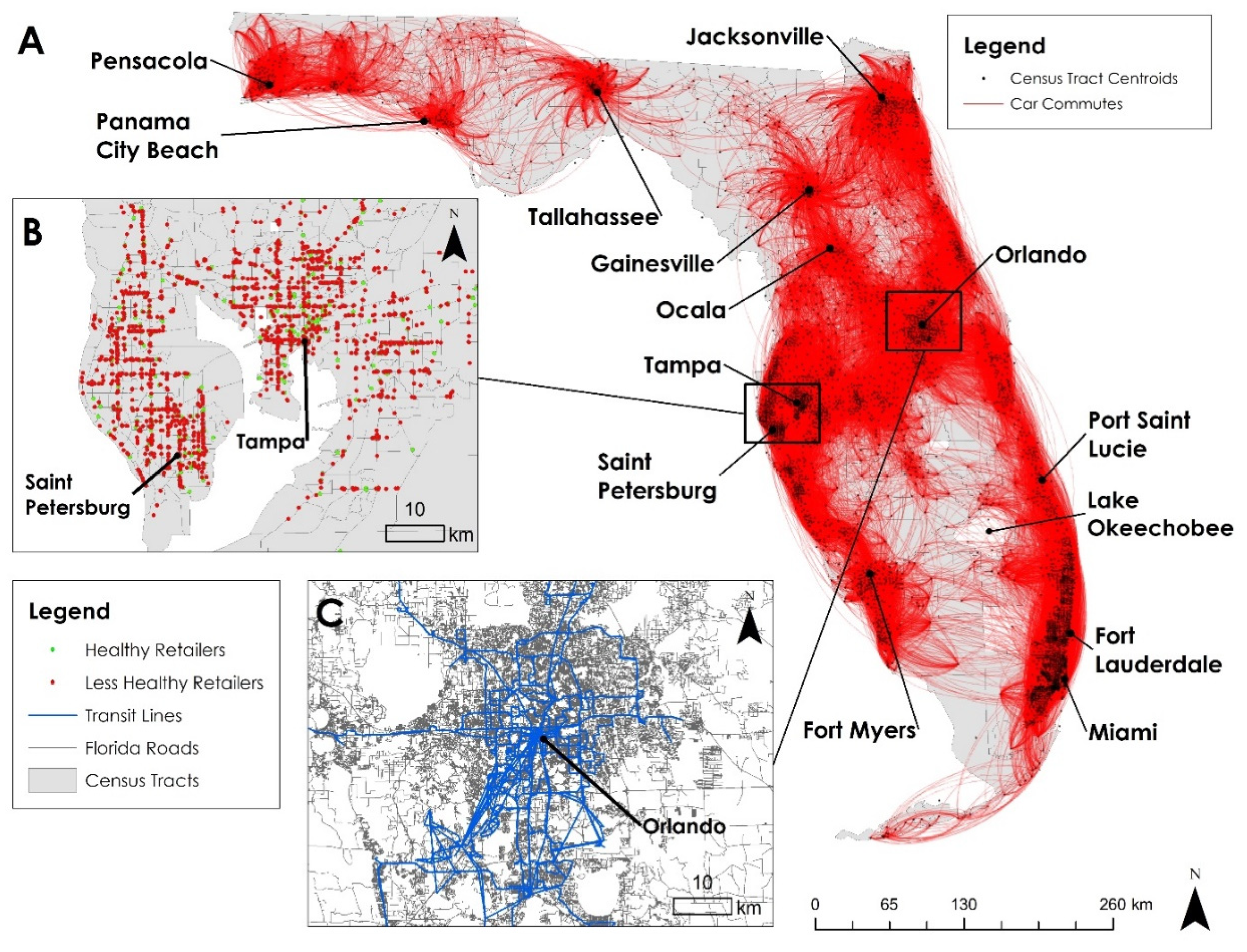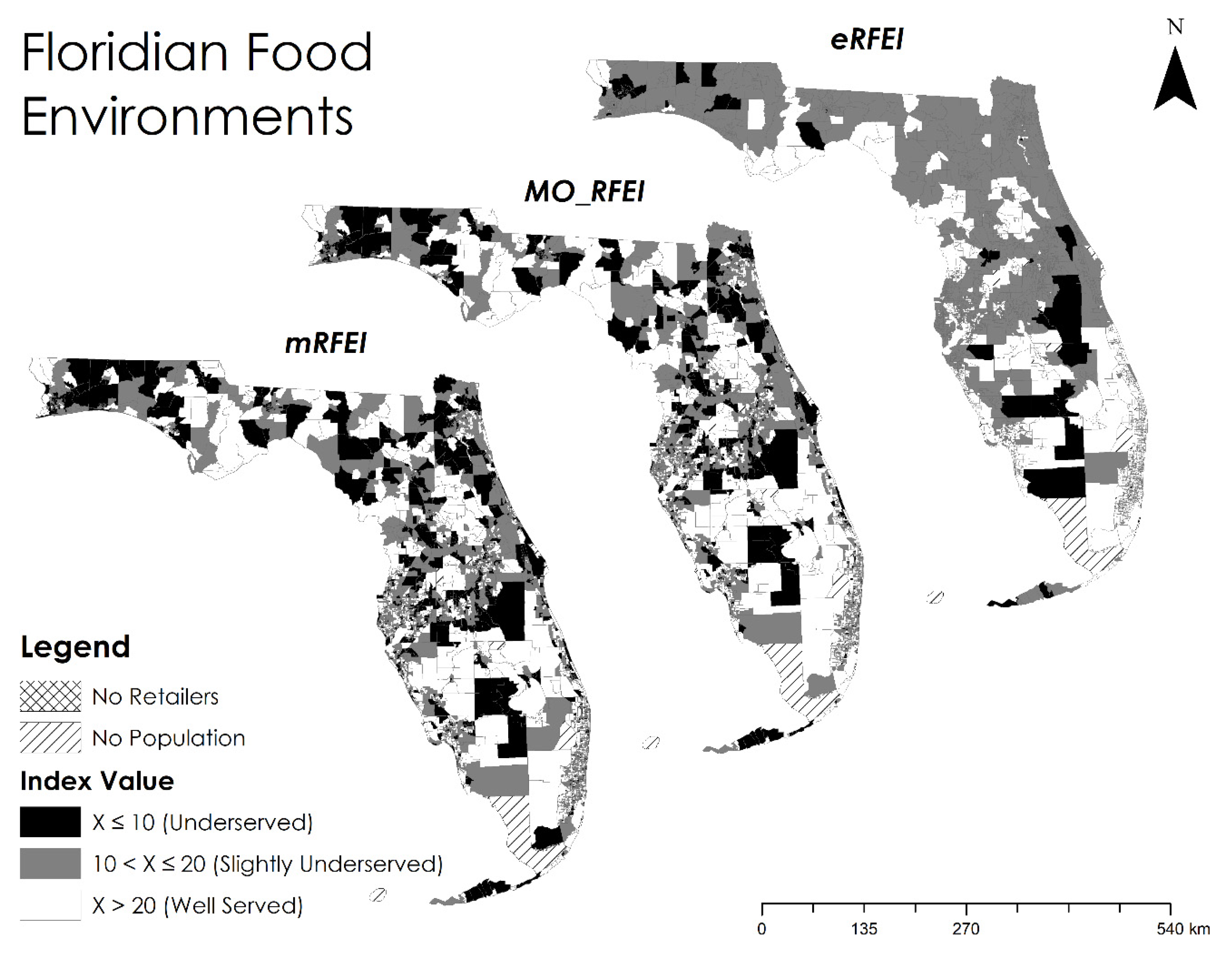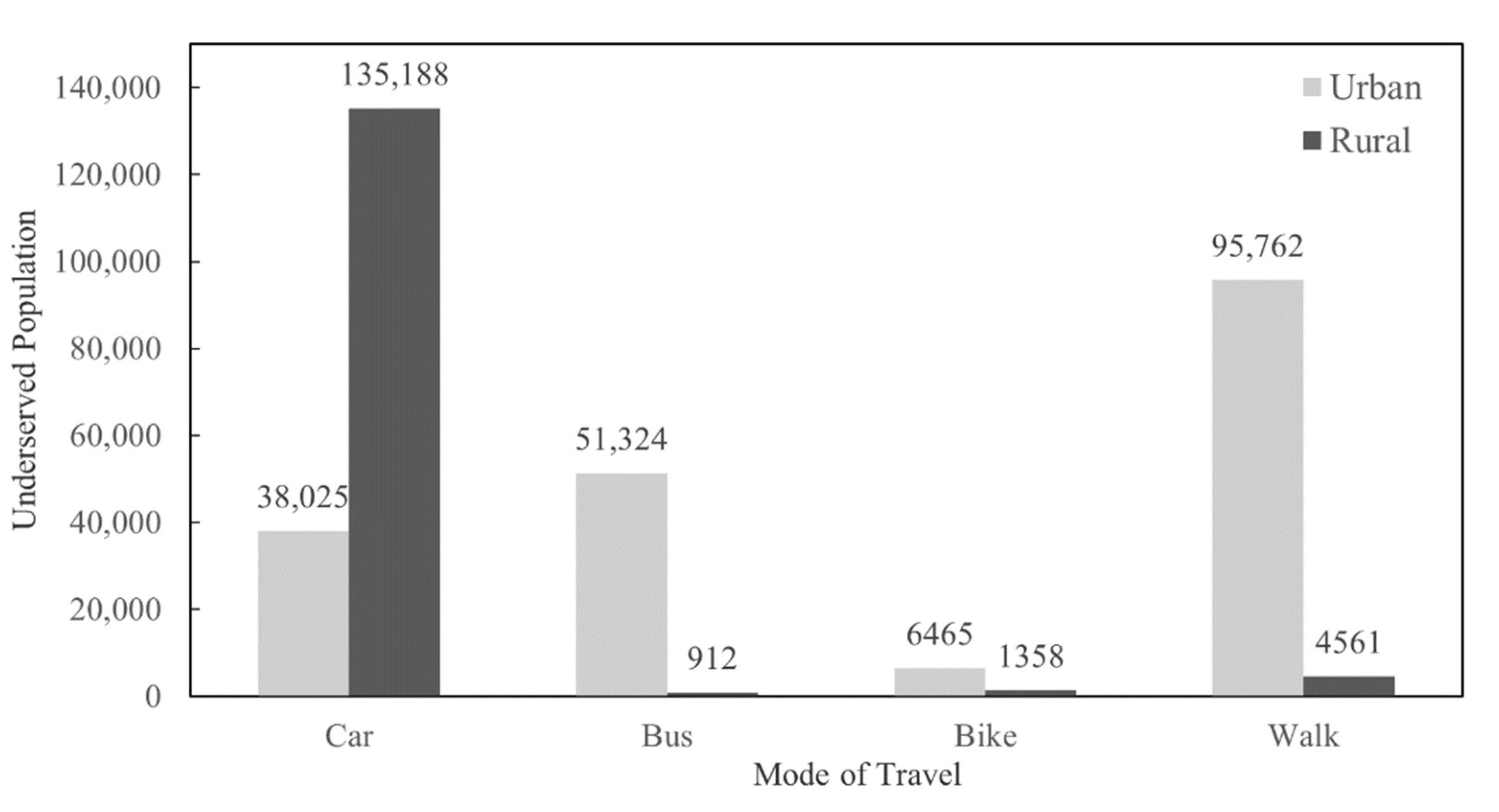Enhancing the Retail Food Environment Index (RFEI) with Neighborhood Commuting Patterns: A Hybrid Human−Environment Measure
Abstract
:1. Introduction
2. Review of Food Environment Literature: Factors, Measures, and RFEIs
3. Methodologies
3.1. The Generic Approach
3.2. mRFEI as a Single-Origin Index
3.3. Multiple Origin RFEI (MO_RFEI)
3.4. Enhanced RFEI for Multiple Origins and Multiple Modes (eRFEI)
4. Case Study: Re-Evaluating Food Environments in Florida
4.1. Study Area
4.2. Data Collection
4.2.1. Census Tracts as Neighborhoods
4.2.2. Commuting between Neighborhoods
4.2.3. Food Retailers
4.2.4. Transportation Networks and Travel Time Estimation
5. Results and Discussion
5.1. Statistical Comparison
5.2. Urban and Rural Disparities
5.3. Underserved Populations by Travel Modes
5.4. Policy Implications
5.5. Generalizability and Limitations
6. Conclusions
Author Contributions
Funding
Conflicts of Interest
Appendix A
| CDC’s Definition Based on NAICS 2011 | Our Modifications to Accommodate NAICS 2017 | |
|---|---|---|
| Healthy food retailers |
|
|
| Less healthy food retailers |
|
|
| BJ’s Wholesale Club |
|---|
| Costco |
| Sam’s Club |
| Super Target |
| Target |
| Walmart |
| Walmart Supercenter |
| A&W Restaurants | Church’s Chicken | Krispy Kreme | Sbarro |
| Applebee’s | Culver’s | Little Caesars | Smoothie King |
| Arby’s | Dairy Queen | Long John Silver’s | Sonic Drive-In |
| Baskin-Robbins | Del Taco | McDonald’s | Starbucks |
| Blimpie | Denny’s | Orange Julius | Steak ‘n Shake |
| Bojangles’ | Domino’s | Panda Express | Subway |
| Burger King | Einstein Bros. Bagels | Panera Bread | Taco Bell |
| Captain D’s | Firehouse Subs | Papa John’s Pizza | Waffle House |
| Carl’s Jr. | Five Guys | Papa Murphy’s | Wendy’s |
| Charley’s Philly Steaks | Haagen-Dazs | Pita Pit | Whataburger |
| Checkers and Rally’s | Hardee’s | Pizza Hut | Wingstop |
| Chick-fil-A | IHOP | Popeyes | WingStreet |
| Chili’s | Jersey Mike’s Subs | Qdoba | Zaxby’s |
| Chipotle Mexican Grill | Jimmy John’s | Quiznos | |
| Chuck E. Cheese | KFC | Rita’s Italian Ice |
| Road Type a | Road Subtype a | Speed Limit (Miles/h) b |
|---|---|---|
| Primary | Interstate Highway | 70 |
| US Route | 65 | |
| Secondary | State Highway | 60 |
| State Route | 55 | |
| County Highway | 50 | |
| County Route | 45 | |
| Local | Local, neighborhood, and rural road, city street | 30 |
| Ramp | N/A | 25 |
| Others | N/A | 20 |
References
- Cooksey-Stowers, K.; Schwartz, M.B.; Brownell, K.D. Food swamps predict obesity rates better than food deserts in the United States. Int. J. Environ. Res. Public Health 2017, 14, 1366. [Google Scholar] [CrossRef] [PubMed]
- Larson, N.I.; Story, M.T.; Nelson, M.C. Neighborhood environments: Disparities in access to healthy foods in the US. Am. J. Prev. Med. 2009, 36, 74–81.e10. [Google Scholar] [CrossRef] [PubMed]
- Black, C.; Moon, G.; Baird, J. Dietary inequalities: What is the evidence for the effect of the neighbourhood food environment? Health Place 2014, 27, 229–242. [Google Scholar] [CrossRef]
- Hilmers, A.; Hilmers, D.C.; Dave, J. Neighborhood disparities in access to healthy foods and their effects on environmental justice. Am. J. Public Health 2012, 102, 1644–1654. [Google Scholar] [CrossRef]
- Raja, S.; Ma, C.; Yadav, P. Beyond food deserts: Measuring and mapping racial disparities in neighborhood food environments. J. Plan. Educ. Res. 2008, 27, 469–482. [Google Scholar] [CrossRef]
- Chen, X. Take the edge off: A hybrid geographic food access measure. Appl. Geogr. 2017, 87, 149–159. [Google Scholar] [CrossRef]
- Walker, R.E.; Keane, C.R.; Burke, J.G. Disparities and access to healthy food in the United States: A review of food deserts literature. Health Place 2010, 16, 876–884. [Google Scholar] [CrossRef]
- California Center for Public Health Advocacy. Searching for Healthy Food: The food Landscape in California Cities and Counties; California Center for Public Health Advocacy: Davis, CA, USA, 2007. [Google Scholar]
- Beaulac, J.; Kristjansson, E.; Cummins, S. Peer reviewed: A systematic review of food deserts, 1966–2007. Prev. Chronic Dis. 2009, 6, A105. [Google Scholar]
- Rose, D.; Bodor, J.N.; Swalm, C.M.; Rice, J.C.; Farley, T.A.; Hutchinson, P.L. Deserts in New Orleans? Illustrations of urban Food Access and Implications for Policy; University of Michigan National Poverty Center/USDA Economic Research Service Research: Ann Arbor, MI, USA, 2009. [Google Scholar]
- CDC. Children’s Food Environment State Indicator Report; CDC: Atlanta, GA, USA, 2011. [Google Scholar]
- Chen, M.; Creger, T.; Howard, V.; Judd, S.E.; Harrington, K.F.; Fontaine, K.R. Association of community food environment and obesity among US adults: A geographical information system analysis. J. Epidemiol. Community Health 2019, 73, 148–155. [Google Scholar] [CrossRef]
- Paquet, C.; Coffee, N.T.; Haren, M.T.; Howard, N.J.; Adams, R.J.; Taylor, A.W.; Daniel, M. Food environment, walkability, and public open spaces are associated with incident development of cardio-metabolic risk factors in a biomedical cohort. Health Place 2014, 28, 173–176. [Google Scholar] [CrossRef]
- Havewala, F. The dynamics between the food environment and residential segregation: An analysis of metropolitan areas. Food Policy 2021, 103, 102015. [Google Scholar] [CrossRef]
- Shannon, J. Beyond the supermarket solution: Linking food deserts, neighborhood context, and everyday mobility. Ann. Am. Assoc. Geogr. 2016, 106, 186–202. [Google Scholar] [CrossRef]
- Turner, C.; Aggarwal, A.; Walls, H.; Herforth, A.; Drewnowski, A.; Coates, J.; Kalamatianou, S.; Kadiyala, S. Concepts and critical perspectives for food environment research: A global framework with implications for action in low-and middle-income countries. Glob. Food Secur. 2018, 18, 93–101. [Google Scholar] [CrossRef]
- Spence, J.C.; Cutumisu, N.; Edwards, J.; Raine, K.D.; Smoyer-Tomic, K. Relation between local food environments and obesity among adults. BMC Public Health 2009, 9, 192. [Google Scholar] [CrossRef] [PubMed]
- Babey, S.H.; Diamant, A.L.; Hastert, T.A.; Harvey, S. Designed for Disease: The Link between Local Food Environments and Obesity and Diabetes; UCLA Center for Health Policy Research: Los Angeles, CA, USA, 2008. [Google Scholar]
- Shier, V.; An, R.; Sturm, R. Is there a robust relationship between neighbourhood food environment and childhood obesity in the USA? Public Health 2012, 126, 723–730. [Google Scholar] [CrossRef] [PubMed]
- Laxy, M.; Malecki, K.C.; Givens, M.L.; Walsh, M.C.; Nieto, F.J. The association between neighborhood economic hardship, the retail food environment, fast food intake, and obesity: Findings from the Survey of the Health of Wisconsin. BMC Public Health 2015, 15, 237. [Google Scholar] [CrossRef]
- Truong, K.; Fernandes, M.; An, R.; Shier, V.; Sturm, R. Measuring the physical food environment and its relationship with obesity: Evidence from California. Public Health 2010, 124, 115. [Google Scholar] [CrossRef]
- Moayyed, H.; Kelly, B.; Feng, X.; Flood, V. Is living near healthier food stores associated with better food intake in regional Australia? Int. J. Environ. Res. Public Health 2017, 14, 884. [Google Scholar] [CrossRef]
- Zhang, T.; Huang, B. Local retail food environment and consumption of fruit and vegetable among adults in Hong Kong. Int. J. Environ. Res. Public Health 2018, 15, 2247. [Google Scholar] [CrossRef]
- Glanz, K.; Sallis, J.F.; Saelens, B.E.; Frank, L.D. Nutrition Environment Measures Survey in stores (NEMS-S): Development and evaluation. Am. J. Prev. Med. 2007, 32, 282–289. [Google Scholar] [CrossRef]
- Charreire, H.; Casey, R.; Salze, P.; Simon, C.; Chaix, B.; Banos, A.; Badariotti, D.; Weber, C.; Oppert, J.-M. Measuring the food environment using geographical information systems: A methodological review. Public Health Nutr. 2010, 13, 1773–1785. [Google Scholar] [CrossRef]
- USDA. Food Access Research Atlas. Available online: https://www.ers.usda.gov/data-products/food-access-research-atlas.aspx (accessed on 17 June 2021).
- Horner, M.W.; Wood, B.S. Capturing individuals’ food environments using flexible space-time accessibility measures. Appl. Geogr. 2014, 51, 99–107. [Google Scholar] [CrossRef]
- Christian, W.J. Using geospatial technologies to explore activity-based retail food environments. Spat. Spatio-Temporal Epidemiol. 2012, 3, 287–295. [Google Scholar] [CrossRef]
- Chen, X. Enhancing the two-step floating catchment area model for community food access mapping: Case of the supplemental nutrition assistance program. Prof. Geogr. 2019, 71, 668–680. [Google Scholar] [CrossRef]
- Dai, D.; Wang, F. Geographic disparities in accessibility to food stores in southwest Mississippi. Environ. Plan. B Urban Anal. City Sci. 2011, 38, 659–677. [Google Scholar] [CrossRef]
- Chen, X.; Kwan, M.-P. Contextual uncertainties, human mobility, and perceived food environment: The uncertain geographic context problem in food access research. Am. J. Public Health 2015, 105, 1734–1737. [Google Scholar] [CrossRef] [PubMed]
- Hu, Y.; Li, X. Modeling and analysis of excess commuting with trip chains. Ann. Am. Assoc. Geogr. 2021, 111, 1851–1867. [Google Scholar] [CrossRef]
- Van Hulst, A.; Barnett, T.A.; Gauvin, L.; Daniel, M.; Kestens, Y.; Bird, M.; Gray-Donald, K.; Lambert, M. Associations between children’s diets and features of their residential and school neighbourhood food environments. Can. J. Public Health 2012, 103, S48–S54. [Google Scholar] [CrossRef]
- Widener, M.J.; Minaker, L.; Farber, S.; Allen, J.; Vitali, B.; Coleman, P.C.; Cook, B. How do changes in the daily food and transportation environments affect grocery store accessibility? Appl. Geogr. 2017, 83, 46–62. [Google Scholar] [CrossRef]
- U.S. Census Bureau. TIGER/Line Shapefiles; U.S. Census Bureau: Suitland-Silver Hill, MD, USA, 2015. [Google Scholar]
- American Association of State Highway and Transportation Officials. Floridian Census Transportation Planning Products (CTPP) Commute Flows; American Association of State Highway and Transportation Officials: Washington, DC, USA, 2010. [Google Scholar]
- DatabaseUSA. Business Database; DatabaseUSA: Omaha, NE, USA, 2020. [Google Scholar]
- Browning, R.C.; Baker, E.A.; Herron, J.A.; Kram, R. Effects of obesity and sex on the energetic cost and preferred speed of walking. J. Appl. Physiol. 2006, 100, 390–398. [Google Scholar] [CrossRef]
- Florida Department of Transportation. Florida Transit Data Exchange: Floridian GTFS Datasets; Florida Department of Transportation: Tallahassee, FL, USA, 2020. [Google Scholar]
- Federal Highway Administration. National Household Travel Survey; U.S. Department of Transportation: Washington, DC, USA, 2001. [Google Scholar]
- U.S. Census Bureau. Urban and Rural. Available online: https://www.census.gov/programs-surveys/geography/guidance/geo-areas/urban-rural.html (accessed on 17 June 2021).
- Su, S.; Li, Z.; Xu, M.; Cai, Z.; Weng, M. A geo-big data approach to intra-urban food deserts: Transit-varying accessibility, social inequalities, and implications for urban planning. Habitat Int. 2017, 64, 22–40. [Google Scholar] [CrossRef]
- Ramirez, A.S.; Diaz Rios, L.K.; Valdez, Z.; Estrada, E.; Ruiz, A. Bringing Produce to the People: Implementing a Social Marketing Food Access Intervention in Rural Food Deserts. J. Nutr. Educ. Behav. 2017, 49, 166–174. [Google Scholar] [CrossRef] [PubMed]
- Sadler, R.C. Strengthening the core, improving access: Bringing healthy food downtown via a farmers’ market move. Appl. Geogr. 2016, 67, 119–128. [Google Scholar] [CrossRef]






| Index | ≤10 (Underserved) | 10 < X ≤ 20 (Slightly Underserved) | ||
|---|---|---|---|---|
| # of Tracts | Population | # of Tracts | Population | |
| mRFEI | 806 | 3,355,703 | 1539 | 7,628,399 |
| MO_RFEI | 619 | 2,445,514 | 1651 | 8,210,267 |
| eRFEI | 55 | 264,499 | 2158 | 10,226,600 |
| Index | Urban | Rural | ||||
|---|---|---|---|---|---|---|
| Mean | Underserved Tracts | Underserved Population * | Mean | Underserved Tracts | Underserved Population ** | |
| mRFEI | 20.08 | 588 | 15.17% | 19.89 | 2168 | 27.81% |
| MO_RFEI | 20.58 | 427 | 10.56% | 19.64 | 192 | 23.05% |
| eRFEI | 20.29 | 24 | 0.66% | 18.57 | 31 | 5.17% |
Publisher’s Note: MDPI stays neutral with regard to jurisdictional claims in published maps and institutional affiliations. |
© 2022 by the authors. Licensee MDPI, Basel, Switzerland. This article is an open access article distributed under the terms and conditions of the Creative Commons Attribution (CC BY) license (https://creativecommons.org/licenses/by/4.0/).
Share and Cite
Glover, B.; Mao, L.; Hu, Y.; Zhang, J. Enhancing the Retail Food Environment Index (RFEI) with Neighborhood Commuting Patterns: A Hybrid Human−Environment Measure. Int. J. Environ. Res. Public Health 2022, 19, 10798. https://doi.org/10.3390/ijerph191710798
Glover B, Mao L, Hu Y, Zhang J. Enhancing the Retail Food Environment Index (RFEI) with Neighborhood Commuting Patterns: A Hybrid Human−Environment Measure. International Journal of Environmental Research and Public Health. 2022; 19(17):10798. https://doi.org/10.3390/ijerph191710798
Chicago/Turabian StyleGlover, Bailey, Liang Mao, Yujie Hu, and Jiawen Zhang. 2022. "Enhancing the Retail Food Environment Index (RFEI) with Neighborhood Commuting Patterns: A Hybrid Human−Environment Measure" International Journal of Environmental Research and Public Health 19, no. 17: 10798. https://doi.org/10.3390/ijerph191710798
APA StyleGlover, B., Mao, L., Hu, Y., & Zhang, J. (2022). Enhancing the Retail Food Environment Index (RFEI) with Neighborhood Commuting Patterns: A Hybrid Human−Environment Measure. International Journal of Environmental Research and Public Health, 19(17), 10798. https://doi.org/10.3390/ijerph191710798






